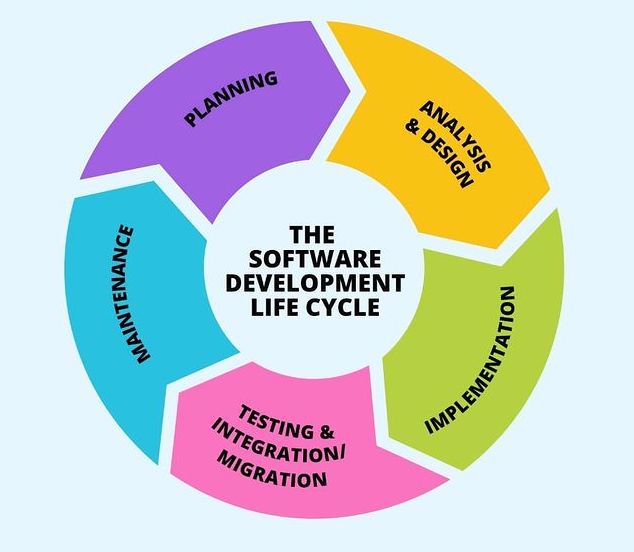It is simply coined as SDLC. And this is a crucial process that will ensure high-quality software. As with products and inventions, the software also has to undergo a specific methodology to ensure its quality. And this life cycle consists of several stages. It begins with a thought and eventually translates into technical aspects.
SDLC entails several models, ideas, activities, and of course, a lot of work. If you’re ever curious how software comes into fruition, but don’t understand the stuff quite well, we are going to break down the 6 stages of a software development life cycle.
Six stages of SDLC
This methodology was concocted not only to ensure high-quality software. It is also employed so that you will be able to make one with the least cost and at the shortest possible time. So you can somehow have a glimpse of how crucial SDLC is in this modern Internet era.
1. Requirement analysis or extraction
It’s not uncommon for clients to have a vague idea of what they want. Oftentimes, the idea is to be vast and general it needs to be broken down. And here is where the requirement analysis takes place. This consists of a team including a software engineer, domain experts, and the sales department. Brainstorming is the key activity here.
The team has to be able to “extract” the specific goal or idea of what the client wants. And to help achieve concrete data, this step is coupled with marketing surveys.
There are questions that will be asked at this point. What is the purpose of the software? How will people benefit from it? And how will it work? These are just some of the more common questions that will be addressed at this stage. And at this stage, current problems should also be identified
2. Feasibility analysis and planning
As the word implies, this is the stage where you have to determine if the software is feasible. When you’re looking for a location for a new restaurant, you often have to do a feasibility study on the location. Will there be more foot traffic? Will people living in the neighborhood buy my food? This is the same with the feasibility analysis.
Planning will be done. The risks will be determined and you have to consider everything at stake. The goal of this stage is to soften the risks and provide quick solutions.
So the overall goal at this stage is to determine if the software development is viable, feasible, or possible. And if it is, it should still present the lowest risk possible.
3. Design phase
Now that you have determined the feasibility of your project, it’s time to translate the software specifications into a design plan. And it’s very important to take note of all the feedback of the stakeholders. You have to develop a system that will allow the smooth exchange of feedback. All data should be collected and translated into a document.
Failure to gather all the needed data and feedback from the stakeholders will likely put the project in jeopardy, it might be shelved due to the lack of viable information.
This stage also involves prototyping. This will give you a clear view of how the software will function. And It often involves several steps too.
- Architecture- this involves identifying the programming language and the overall design of the software
- User interface- this will identify how the software will interact with the users.
- Platforms- on which platform will the software run- Android, Linux, Apple, or Windows?
- Programming- this identifies the methods of solving problems
- Communication- this will identify how the software will communicate with the server etc.
- Security- this will point out what security measures will be used to make sure that the data is safe. It will often include password protection, SSL, and traffic encryption.
3.5 Coding stage
This is where the software is coded and made cohesive with the specifications of the client. A small project may be done by a single developer only. While larger projects need more heads or even a number of teams. And this can be challenging because everyone has to be aligned and in tune with the standards set by the client.
That’s why an access code can be used to ensure that everyone is in the loop. This also enables everyone to find errors and fix any glitches asap.
Another step that is also crucial in the coding stage is documentation. It can be as simple as a user guide or putting comments in the source code. Written documentation such as FAQs, tutorials, and troubleshooting guides are not mandatory. But you’ll find that they come in very handy. This will allow everyone to identify future problems.
4.Testing phase
This is the stage where the code is run and tested for bugs and glitches. It will also pinpoint challenges users will likely encounter when using the software. It’s a dry run.
As with all events, dry runs are crucial. This will help you smoothen out the entire project and see everything from the user’s perspective. Thus, it will be able to give users a better experience.
5. Deployment
This is where the software is launched and made available to the public. It can be as simple as downloading an app for putting a download option on the website.
But it can also be complex. If a whole company website is to be upgraded, it will take time for the entire software to be fully launched.
6. Maintenance and operation
After a successful launch comes maintenance and operation. This may seem like it’s time to lie low, celebrate, and relax. But just not yet. This is still a very critical stage though it’s at the end of the SDLC. Why? Because new issues and bugs can sometimes arise, these are those that did not show up during the testing stage.
These issues then need to be resolved and they will enter into a new life cycle.
SDLC Models
We have mentioned the 6 stages of SDLC. And these stages are further streamlined using one of the SDLC models. Let’s take a look at what differentiates one from the other.
Waterfall model
This is the old-school, traditional model. The challenge with this model is that problems and issues have to be identified and addressed at the earlier stages. Otherwise, the entire project may be put in jeopardy.
V-shaped model
This is also known as the verification and validation model. It’s similar to the Waterfall design, except that there is a testing phase for each development stage. Thus, eliminating the cons of a waterfall model.
Prototype model
The software will be developed based on user feedback. The goal is to satisfy the user’s requirement. The advantage of this model is that it will be easier to meet the requirements since it’s already set by the user. But the disadvantage is, the quality can be compromised, so the correction might take longer or even forever.
Iterative model
This model involves identifying the requirements, testing, developing, then filling out additional requirements. Once done, a new model will be created and it will also undergo the same process. Hence the name iterative.
The steps are repeated over and over again until the software is finally completed.
Spiral model
This is similar to the iterative phase. The software has to undergo several steps several times until the product is refined. This is also the most flexible model. And If you’re looking for a more customizable product, this is the ideal SDLC model to use.
Big bang model
This model does not entail much planning. Instead, there is much time spent on development. Like the big bang theory, it just burst out within knowing where it came from, thus the little planning involved.
This is ideal only for small projects where one or two software engineers are commissioned.
Agile model
The major difference of this model is that it includes not only the developers but also the consumer in developing the project. This customer feedback has a lot of impact. It can be consumer-satisfying. But if the selected consumer doesn’t know which direction he wants to go, it can be a big mess.
Final say
It seems endless right? Yes, that’s why it’s called a life cycle. Whenever new problems arise, the product will have to enter into a new life cycle. Whenever there are upgrades, it will also enter into a new life cycle.
SLDC is very critical because it shows you what is happening and if there is any room for improvement


